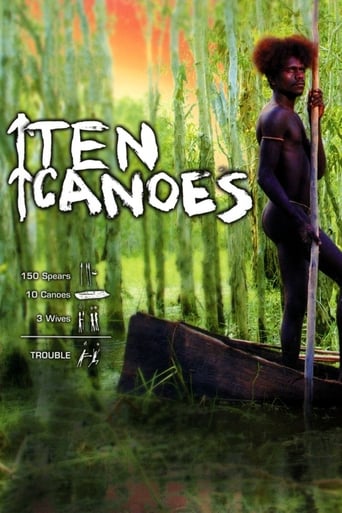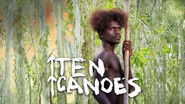tedg
Sometimes all you need is magic. At least it seems so, when you see the real thing. If you happened to see Baz Luhmann's "Australia" and was confused, see this instead. It is the genuine article, about the magic, told with magic. It is circular, nested and webbed. It floats, and if you let it you will nearly be lost.The cinematography here — all the cinematic values — are only slightly apparent and when they declare themselves, it is in the service of the story: switching from subdued color to bright to signal the shift of what story you are in. Otherwise, the camera is either in conventional documentary mode or in space following spirits across landscapes as they voyage from waterhole python ouroboros and back.What we have here is good old oral storytelling supplemented by image, and highly structured. Essentially everything is told by an offscreen aboriginal narrator, whose convoluted beginning establishes all sorts of narrative pockets that are revisited later. The story is a tree, we are told and in its telling we visit many branches. There is a sort of beginning, but it is nearly too complicated to describe. There is an ending, but no. After a chuckle the narrator tells us he has no idea how it ends.Ostensibly, the story is told by the off-screen narrator, of a hunting party of aboriginal men, who make ten bark canoes and go hunting and gathering in the swamp. Over that period in the story, a wise man tells a story to his impatient much younger brother. That "inner" story shifts to color. It is supposed to be in a time in between creation and the full solidifying of men on earth. So the characters in the inner story are played by the folks in the outer one, and the main threads are folded together: a matter of the young man's desire for the older brother's youngest wife.But that is the merest of threads. We are told that the story is a tree. We literally see that tree shorn of bark and made into simple canoes. We literally see our hunters — in both stories — camping in trees. The story seems to ramble. There is sorcery, mystery, charmed turds. There is revenge, jokes, anthropology. Its all of a context. A point of all this is that there cannot be a point in the western sense. There isn't a linear narrative here with a message. There is a walkabout through a storyspace.The very first event we see tells us this in a remarkable way. Our ten men are walking single file and the last man halts the party. He refuses to be last, he says, because someone is farting. The line is consequently reshuffled. It is a gentle device, one that sets the magic for what "follows," a non-linear shuffle.The joke at the end has the same form. The last one (the youngest wife) is not how the thing ends.The entire production, we are told, uses aboriginal talent exclusively. You want to know the narrative power of carefully folded (meaning here: intuitively structured) narrative? See this.Ted's Evaluation -- 3 of 3: Worth watching.
bandw
This story begins with an aerial flyover of Arnhem Land in northern Austalia. A narrator comes on saying that he is going to tell a story, his story. His story starts with the recounting of a tale about his ancestors of a few generations back who are making canoes to traverse a crocodile-filled swamp in search of goose eggs. Within that tale a wise older man is telling another, somewhat parallel, tale to his younger brother dating back many generations to "the ancients." In a clever plotting device the ancestor's tale is shown in black and white while the ancient's tale is shown in color. This technique has the dual effect of allowing director Rolf de Heer to duplicate scenes from black and white photographs taken in the area by an anthropologist in the 1930s (photographs that motivated the making of this film), as well as helping the viewer keep the stories straight.The cast consists of a few dozen modern day aboriginals playing the parts in the two stories. They try to capture the reality of the times portrayed, and you can believe that this was the way it could have been thousands of years ago for a tribe of early humans. The earlier Astralians have their own customs and language and the cast speaks in their native language, with English subtitles. I kept thinking of how the basic emotions driving the stories are still with us--fear, jealousy, lust, love, trust, distrust, pride, humor, courage, loyalty, honor. The culture presented is indeed not mine, but it is perfectly understandable. Sorcerers keep the tribe stirred up and mystified with special knowledge of "magic," just as modern religions do (with equal effectiveness). There are laws that must be obeyed, even if unwritten. The young men relish showing prowess in hunting and war making. A creator is deemed the prime mover. Marital relationships are not always harmonious, especially if polygamous. And so on. It appears that no matter how it manifests itself a culture will wrap itself around basic human emotions and desires. It would not be a stretch to recast these stories in a modern setting.The photography of the landscape is beautiful and sensuous; it contributes greatly to the stories by showing what an intimate relationship early peoples had with the land and its fauna.This movie helps us better appreciate where we came from and what we are.
Red-125
Ten Canoes (2006), directed by Rolf de Heer and Peter Djigirr, is the first movie I've seen that portrays only Australian Aboriginals. Movies like "Walkabout" and "The Chant of Jimmy Blacksmith" portray the clash of cultures between European Australians and Aboriginal Australians. However, "Ten Canoes" is different. The entire story is about Aboriginals, and no non-Aboriginals intrude.The film is set in pre-colonization Australia, with flashbacks to a far earlier time. The basic plot--the love of a younger brother for his older brother's wife--is not unique. What is unique about this film is the manner in which the plot unfolds, and the glimpse it gives us into (presumably authentic) Australian Aboriginal culture.The film is definitely worth seeing, and will probably work well on DVD if it's not playing at a theater close to you. Incidentally, the narrator of "Ten Canoes" is David Gulpilil, who, in 1971, starred as "the Black boy" in "Walkabout."
Seamus2829
I had the good fortune of coming across this (somewhat)overlooked gem when it played at one my local art cinemas recently. 'Ten Canoes' is one of those films that is an open window to another culture (albiet one that is still regarded as a mystery to Westerners). It is a multi layered story about love,lust,envy,mistaken identity,revenge,etc. What I admired about it is the fact that it's told as a story within a story within a story,and is shot both in black & white & colour (to transpire time). I guess if I have only minor beef with this film is the fact that although it takes place thousands of years ago, it has to pander to toilet humour from time to time to attract the audiences of today. That aside, Ten Canoes can easily take it's place among other films within this genre (Salt Men Of Tibet,Pathfinder--the original Norwegian edition,and not the tepid American remake of recent,as well as others). It's one of those odd little films that you'll probably have to seek out,as it won't play in mainstream cinemas (it contains yards of male,as well as female nudity--although it contains absolutely no graphic sex scenes)



